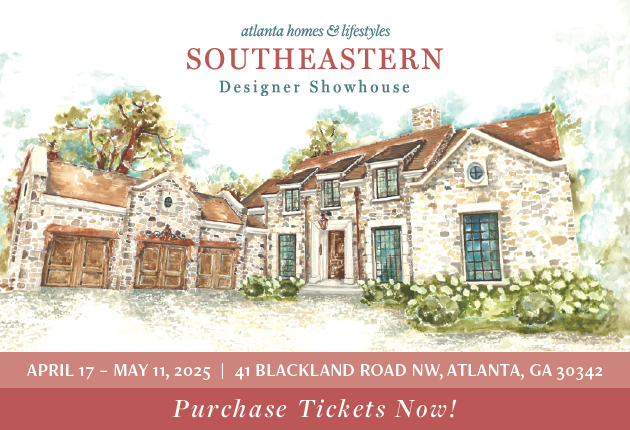Storied Charm
Architect Keith Summerour and interior designer Liza Bryan renovate a classic Atlanta estate with an eye to historical authenticity and distinguishing grace.

Few homes match the grandeur of Atlanta’s natural beauty, but the Charles Case House in Buckhead rivals the city’s springtime profusion with its masterful grace, perfect proportions and exquisite attention to detail. Architect Neel Reid designed the renowned residence, which he named Somerset House, in 1919, modeling the design on Tintinhull House in England. Huge limestone eagles perched on bold columns at the front driveway are the hallmarks of this distinguished residence and provide the basis for its alternate name, Eagle House.
Throughout the 20th century, the house endured a series of modifications that were not always in keeping with Reid’s original aesthetic. The new owners brought in Atlanta interior designer Liza Bryan, architect Keith Summerour and contractor Jim Eiland of C & E Remodeling to ensure that it would remain historically referenced as it transitioned into the 21st century. “It had such great bones that it immediately spoke to me,” says Bryan.
Significant research went into restoring the home. “We studied historic properties from Newport to the Hudson River Valley to England in order to achieve authenticity throughout the house,” says the designer.
Architecturally, the house needed considerable changes to accommodate a new kitchen and family room. By adding an 18-foot addition across the entire back of the house, Summerour created significantly more space while preserving the original architectural footprint and maintaining a seamless blend with the original structure. “What he did was so simple but pure genius, and I’m certain Neel would have done this too,” confirms Bryan.
Keeping with the preservation mission, the house was remodeled with materials appropriate to the time of the original construction. Plaster walls, proper hardware and carefully researched paint colors yield not only a home with verticality and great light, but one that is also historically accurate.
The clients’ extensive collection of antiques and decorative arts dictated the interior design, while their collection of period Turkish carpets determined the color palette. Sumptuous traditional draperies and antiques fill the rooms, but “we used brightly colored fabrics to give life to all the spaces,” says Bryan.
As a nod to the home’s name, Bryan found ways to integrate eagles into the design. Dramatic eagle finials cap drapery rods in the living room, while a large platter from the owners’ collection of Royal Crown Derby china rests on a custom water-gilt eagle sconce above the fireplace.
Fortunately, the exterior of the house needed only minimal modifications. After cleaning the original limestone exterior, Bryan brought in lighting designer Joanne Sims, who created new lanterns based on Regency patterns. Under the deft hand of celebrated landscape architect John Howard, the mature, lush landscape continues to evolve and flourish.
It’s the resounding commitment of both the homeowners and those involved in the restoration that ensures the Eagle House will remain a treasure for generations to come.





















